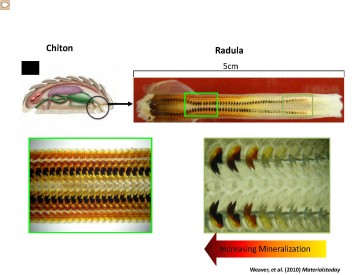The ‘wandering meatloaf’ is a species of marine snail (or chiton) that has extraordinary teeth according to the Jan. 16, 2013 news item on ScienceDaily,
An assistant professor [David Kisailus] at the University of California, Riverside’s Bourns College of Engineering is using the teeth of a marine snail found off the coast of California to create less costly and more efficient nanoscale materials to improve solar cells and lithium-ion batteries.
…
The paper is focused on the gumboot chiton, the largest type of chiton, which can be up to a foot-long. They are found along the shores of the Pacific Ocean from central California to Alaska. They have a leathery upper skin, which is usually reddish-brown and occasionally orange, leading some to give it the nickname “wandering meatloaf.”
Over time, chitons have evolved to eat algae growing on and within rocks using a specialized rasping organ called a radula, a conveyer belt-like structure in the mouth that contains 70 to 80 parallel rows of teeth. During the feeding process, the first few rows of the teeth are used to grind rock to get to the algae. They become worn, but new teeth are continuously produced and enter the “wear zone” at the same rate as teeth are shed.
The University of California Riverside Jan. 15, 2013 news release by Sean Nealon, which originated the news item, describes the chiton’s teeth and the specifics of Kisailus’ inspiration (Note: A link has been removed),
Over time, chitons have evolved to eat algae growing on and within rocks using a specialized rasping organ called a radula, a conveyer belt-like structure in the mouth that contains 70 to 80 parallel rows of teeth. During the feeding process, the first few rows of the teeth are used to grind rock to get to the algae. They become worn, but new teeth are continuously produced and enter the “wear zone” at the same rate as teeth are shed.
Kisailus, who uses nature as inspiration to design next generation engineering products and materials, started studying chitons five years ago because he was interested in abrasion and impact-resistant materials. He has previously determined that the chiton teeth contain the hardest biomineral known on Earth, magnetite, which is the key mineral that not only makes the tooth hard, but also magnetic.
…
Kisailus is using the lessons learned from this biomineralization pathway as inspiration in his lab to guide the growth of minerals used in solar cells and lithium-ion [li-ion] batteries. By controlling the crystal size, shape and orientation of engineering nanomaterials, he believes he can build materials that will allow the solar cells and lithium-ion batteries to operate more efficiently. In other words, the solar cells will be able to capture a greater percentage of sunlight and convert it to electricity more efficiently and the lithium-ion batteries could need significantly less time to recharge.
Using the chiton teeth model has another advantage: engineering nanocrystals can be grown at significantly lower temperatures, which means significantly lower production costs.
While Kisailus is focused on solar cells and lithium-ion batteries, the same techniques could be used to develop everything from materials for car and airplane frames to abrasion resistant clothing. In addition, understanding the formation and properties of the chiton teeth could help to create better design parameters for better oil drills and dental drill bits.
Here’s a representation of the teeth from the University of California Riverside,

A series of images that show the teeth of the gumboot chiton (aka, snail, aka, wandering meatloaf)
You can find other images and media materials in the ScienceDaily news item or the University of California Riverside news release. This citation and link for the research paper is from the ScienceDaily news item,
Qianqian Wang, Michiko Nemoto, Dongsheng Li, James C. Weaver, Brian Weden, John Stegemeier, Krassimir N. Bozhilov, Leslie R. Wood, Garrett W. Milliron, Christopher S. Kim, Elaine DiMasi, David Kisailus. Phase Transformations and Structural Developments in the Radular Teeth ofCryptochiton Stelleri. Advanced Functional Materials, 2013; DOI: 10.1002/adfm.201202894
This article is behind a paywall.